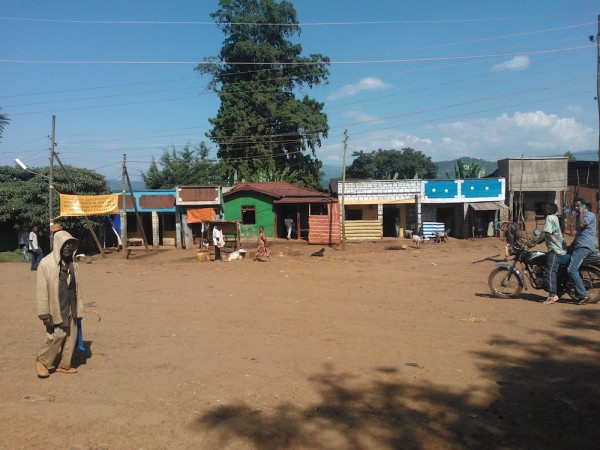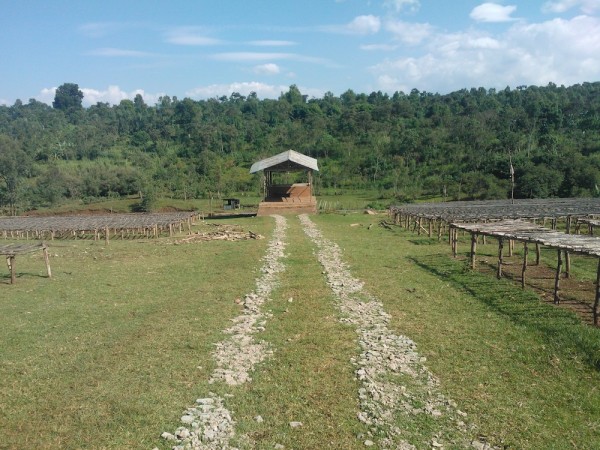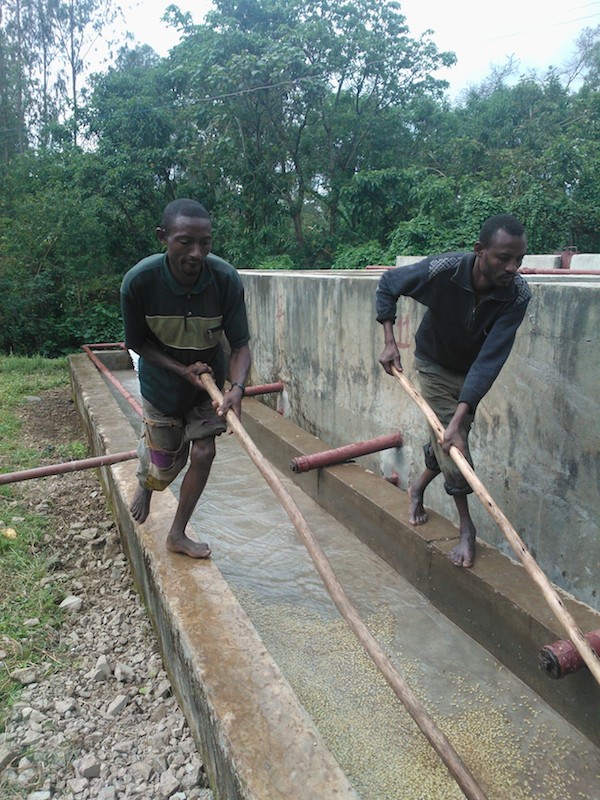by Robert Leigh
(Portions of this post come from Leigh’s latest novel, From Lime Street to Yirgacheffe: A True Story, of Sorts.)
Eight months ago, I travelled to Ethiopia as a full-fledged, card-carrying member of the coffee industry. Yours truly was a quality manager who spent his days in the sample room of a small coffee importer in Liverpool, England. It was there that I first came across, and fell in love with, the coffees of Yirgacheffe. So when a trip to my favorite African region was suggested in a weekly meeting, I dismissed the stack of samples sitting on my desk, ignored the overflowing inbox, and packed a bag.
I was traveling with two colleagues, and would be meeting a third who had been based in Addis for over a year. I would be lying if I said I didn’t have reservations about the trip. As a child, I had seen the horrific televised images of famine and poverty that had ravaged Ethiopia in the Eighties. They made a lasting impact on me. But once there, I was soon captured by a sense of openness, of an incredibly verdant landscape that stretches far and wide. Hours traveling by car can pass before you see the next Gojobate or farm. Of course, that isn’t true of Addis, a true Metropolis where the juxtaposition of rich and poor is so very obvious.
The vast majority of the first day of the trip was spent driving away from Addis, down through the Riff Valley, heading towards Hawassa. It was humbling to know I was following the same byways that had cradled the first of our species. Two hours of driving and I had seen acacia trees, wondering goats and cattle, a handful of farmers. Travel two hours by car in Britain and you’d probably have passed through at least two major cities and lost count of the number of towns and villages.
After a night in Hawassa, and a breakfast of injara, we pressed on, heading deeper into the southern region of Sidamo, stopping in Yirg Alem were we were joined by our translator, who would be with us for the remainder of our visit. Our 4×4 was put through its paces as we climbed potholed roads and twisting tracks, heading toward the town of Kebado. After a quick stop for water, we left Kebado’s sun drenched town square and headed along another rough track surrounded by dense foliage on both sides. Ahead of us, a grey metal gate blocked our path. The gate opened slowly, creaking at the hinges. Beyond its barrier, I saw my first washing station.
Once we had parked, I remained by the car for a while, looking out over the hundreds of hand-crafted wooden drying tables, standing empty and waiting to receive newly washed parchment. The green valley-side beyond the tables undulated in the breeze. We followed the washing station owner to a central, metal roofed building — home to the pulper. A nocturnal beast, the pulper was sleeping in the mid-afternoon heat. I remember feeling a little jealous of the pulper. Outside the pulper’s lair, concrete washing tanks and channels waited for the flow of fresh water and de-fleshed cherries. Where were the cherries? Still on the trees — a few weeks of cool weather had stunted ripening and the farmers were hesitant to harvest until they had a crop worth its weight in birr. How many birr? According to the washing station manager, around seven or eight per kilo, depending on quality. During my visit, I was exchanging sterling at a rate of 29 birr to the pound. I’ll let you do the rest of the sums.
After leaving the sleeping washing station, we headed to Dilla. Like Addis before her, Dilla was bustling. Her crowded streets were home to market stalls and wandering preachers. Cafes and shops stood side by side while trucks and buses trundled along the narrow, asphalt high road. Ten minutes driving down that high road, and we were again part of the rolling green that I have come to associate with Ethiopia.
We’d been driving for around two hours when the back left tire of our 4×4 gave up and burst. As we left the car, a local man headed towards us, pointing at the shredded tire. Our translator said he wanted to help. A second later another man joined us, along with his three sons. I turned around and counted seven children, then thirteen, then twenty. In what seemed like only minutes we had been joined by nearly forty people. Across the road I counted three wooden houses. Where had everyone come from? To this day, I have no idea, but everyone wanted to help our stranded band of foreign coffee fanatics get back on the road. We even received a push after we’d changed the tire.
Our next stop was Yirgacheffe. We were spending the night in the town of Dumerso, sleeping in a guest house surrounded by forest on all sides and watched over by a guard carrying an AK-47. There had been a power failure, and with a cloudless sky above, the entire cosmos seemed to swirl overhead. We took a wonder down Dumerso’s only road, looking for food whilst enjoying a stretch of the legs after being cooped up in the 4×4 for most of the day. When we were spotted by youngsters, a call of “yoyoyoyoyoyo” would be heard. We would turn, and there would be an 8-year-old, grinning from ear to ear and waving.
After dinner at a local hotel, we returned to the guest house, where we planned a visit to another washing station, one that was operational and working through the night. Finally, I thought, actual coffee in motion. I had spent hours back in our office in Liverpool, reading about the processing of cherry. This would be real action.
We had arranged to travel to the washing station by Bajaj. For those who are unfamiliar with this mode of transport, in essence there is a two seater sofa strapped to the back of a moped, with an aluminum roof and stitched leather covering the open sides. It’s worth noting that Bajaj are banned from the streets and roads of Addis, because they are deemed “too dangerous.” Every other road in Ethiopia is fine, according to the Ethiopian government, just not the ones in Addis.
With a failing headlight, and an engine that sounded like it hadn’t been serviced in years, we motored along the potholed road at around 40kph. I will happily admit to being a little worried, particularly when my Bajaj partner pointed to the plastic screen in front of the driver and asked, “Can you see anything through the windscreen?” I couldn’t, which meant the driver couldn’t. “It’s Ok”, my companion reassured, “I’m sure they know this road like the back of their hands.”
We arrived at the washing station in one piece and were immediately greeted by the smell of sour milk clinging to the cool night breeze. The aroma intensified as we neared the washing tanks. Fermentation is a strange and fascinating thing. Without it, we wouldn’t have bread, wine, beer and of course, washed coffee. I just wasn’t expecting one of nature’s greatest gifts to smell quite so sour. The pulper was busy at work, its toothed wheels stripping the flesh from ripe cherries, fed down from a concrete hopper above. Leaves and sticks, the detritus of harvest, hadn’t escaped the maul, and were being removed by hand from the stream of water and freshly milled parchment heading away from the pulper.
The parchment continued to flow along the stream before pouring out into one of four concrete washing tanks. I watched two men — both holding what looked like long, wooden oars — agitating the water and parchment as the tank continued to fill.
Wandering away from the working mill, I saw a truck being unloaded. Five thousand kilos of cherry, bought that afternoon from a weighing station a few miles down the road, was being unloaded by men in long, second-hand coats. Each sack was weighed and logged before being emptied into the hopper feeding the pulper. We all stood back, not wanting to get in the way of progress, and were joined by the station manager who proudly discussed the mills large output numbers. “Why don’t you come back in the morning”, he suggested. “We will be sorting some cherry for sun drying and spreading out the parchment for drying.”
The next morning, with the light on our side, I was able to absorb the full scale of the operation. Three hundred drying tables, each around 15 meters long, spanned out in every direction. A huddle of women had gathered at the bottom of the hill where a station supervisor allocated the day’s work from a clipboard. The station manager offered us coffee and freshly baked bread before we began strolling along the tables. Forty to 50 women lined a table, sorting through the cherry set aside for sun drying. They sang as they worked, swaying to their own a capella rhythm as the work continued. Each cherry was inspected, the ripe remained on the table, the under- and over-ripe thrown into plastic buckets. These cast-offs wouldn’t be wasted, they would simply be processed as second grades. We were watching the export grades being handpicked, the Q1s and 2s. Almost 30,000 kilos had arrived the previous night and each kilo would be picked by hand. This labor-intensive process would go on for weeks. Those picking would receive 10 birr a day for their efforts (approximately €0.38 or $0.51 USD). The economics made this level of dedication to quality hard to fathom.
After a few more days of visiting washing stations and co-ops, we headed back to Addis, following the parchment to the last stop of its journey before export. Inside one of Addis’s many exporter warehouses, I watched complex machinery mill away the parchment husk to reveal the green bean waiting inside. Now unveiled, the naked beans were transferred to a sorting room where defective beans were picked, again by hand, before being poured into jute bags. All that remained was for the truck to arrive and the journey to Djibouti, where the beans would be loaded onto ships and sent around the world.
That brings me to now, eight months on. Redundancy has put an end to my days in the sample room — these things happen. But I still often think about Ethiopia, and believe it is appropriate to draw comparisons between the people working to harvest and process, and those who roast and extract to produce the coffee we all feel so passionately about. The attention to detail, on both sides of the chain, is mind-bending. While the women pick the cherry around the table, the blender is working gram-by-gram to produce the perfect espresso. People on both ends of the chain face the daily struggle to secure a livelihood, while pushing the boundaries of quality within their own little corner of the coffee universe.
Since my return, I have become somewhat of an Ethiopian coffee bore. There is now a standing joke within my circle of friends, “You went for coffee with Rob? Let me guess, he told you about his trip…” I don’t care how many eyes roll. People should have at least some understanding of the effort — and limited financial reward — that goes into a product that many take for granted. Would I go back? Absolutely. I flick through the photos taken when I was there, and each one still brings a smile to my face. But the impression that is most lasting, the one I hope I never forget, is the singing around the drying tables.
Robert Leigh
After bartending his way around Spain and the West End of London, Robert Leigh returned to his home city of Liverpool and began writing. Since then, Robert has completed several works, including his first travel novel, From Lime Street to Yirgacheffe (a true story, of sorts...). He lives in Liverpool City Centre and continues to write in numerous genres.











Comment